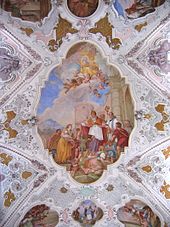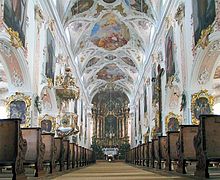St. Martin (Fischbachau)
The Catholic parish church of St. Martin ( Martinsmünster ) in Fischbachau was rebuilt in 1492 after a fire. The previous church was built from 1096 to 1110 as a monastery church of a Benedictine monastery .
history
The monastery was originally founded around 1080 by Haziga von Diessen in Bayrischzell , then moved to Fischbachau in 1085 and to the Petersberg near Erdweg near Dachau in 1104 , until it finally found a permanent home in Scheyern in 1119 . The Fischbachau monastery church was built there during the relatively short period of the monastery.
The previous church burned down together with the other monastery buildings in 1492, but was rebuilt. The church was redesigned in Baroque style from 1628, with a sacristy being built in place of a side abside. Around 1700, under the direction of Johann Mayr d. Ä. the main apse, built a tower east of the apse and enlarged the windows. From 1733 there was a comprehensive redesign with the installation of a wooden barrel and the sheathing of the pillars. Around 1765 the equipment was added.
Furnishing
The stuccoing of the church comes from several phases of development: Already in 1692 there were cast apostle crosses by Leonhard Mayr , around 1737/38 the stucco of the central nave with banding etc., about the same time that of the side aisles in a slightly different way, in 1765 additional rocaille stucco was added.
A total of 73 frescos were created by Melchior Puchner from Ingolstadt around 1737/38 , scenes from the life of St. Martin in the main nave .
The high altar in the Rococo style was designed around 1765. It has six columns, and the monastery donor Haziga is depicted on the altarpiece by the Freising court painter Johann Baptist Deyrer . The stucco pulpit with oil paintings by Sebastian Troger comes from the same construction phase. Parts of the other furnishings, such as the south side altar, date from 1735, otherwise mostly from around 1765. A font made of red marble was preserved from the late Gothic furnishings.
From 2006 the church was renovated and restored under the direction of Christiane Hüpping (Archbishop's Ordinariate). The German Foundation for Monument Protection supported the work financially.
organ
The organ was built in 1920 by Leopold Nenninger . It has a cone store and 26 stops on two manuals and a pedal . In the 1990s, Anton Staller converted it from a pneumatic to an electric action . The disposition is:
|
|
|
|||||||||||||||||||||||||||||||||||||||||||||||||||||||||||||
- Coupling : II / I, II / P, I / P, Supercoppel in II, Supercoppel II / P, Supercoppel II / I, Subcoppel II / I
- Playing aids : 2 free combinations, crescendo roller, swell kick for II
- Remarks: cone chest, electric play and stop action
literature
- Georg Dehio : Handbook of the German art monuments . Bayern IV: Munich and Upper Bavaria. Munich 1990, p. 288ff.
- Klaus Kratzsch: District Miesbach (= Bavarian State Office for Monument Preservation [Hrsg.]: Monuments in Bavaria . Volume I.15 ). 2nd improved edition. Munich / Zurich 1987.
Web links
- St. Martin Monastery Church on the website of the Fischbachau community
- Photos of the furnishings in the churches of St. Martin and St. Mariä Schutz in Fischbachau, in the Warburg Institute Iconographic Database .
- Article of the Münchner Merkur on the renovation
Individual evidence
- ^ Karl Bosl (Ed.): Handbook of the historical sites of Germany . Volume 7: Bavaria (= Kröner's pocket edition . Volume 277). 3. Edition. Kröner, Stuttgart 1981, ISBN 3-520-27703-4 , p. 198.
- ↑ Bavarian organ database online
Coordinates: 47 ° 43 '12.5 " N , 11 ° 57' 2.4" E



